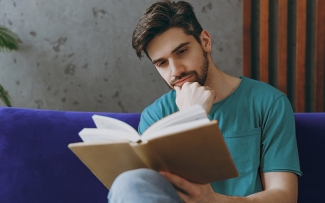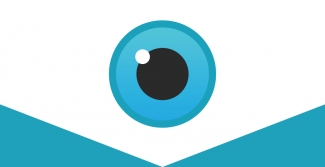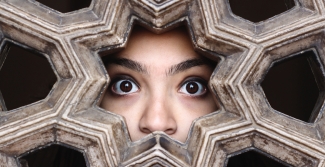Between the lines – reading and eye movement
Did you know that people use the same section of their brain to recognise faces as they do when reading words?
That means when you are enjoying your favourite book or looking at a message on your phone, your brain is actually viewing the words as pictures. Those pictures then travel from your eyes to the letterbox region of your brain, where they get mapped into information about sounds and meanings.
Pretty interesting, huh? And it’s all happening right now as you read this sentence.
Now that you’ve got the picture or, better yet, pictures. Let’s take a deeper look into how eye movement plays a role in understanding words as images, learn about the patterns that help us read, and close the book on some common myths about how reading affects our eyes.
The eye’s role in the science of reading

When our eyes scan across text, our brains filter the texture of the typeface. Character shapes alongside the space inside and around letters send snapshots to our minds to assemble a mental picture of what we’re viewing. While our eyes are busy distinguishing the curve of an S and the dot of an I, our brains start combining that information into context. By linking meaning and thought to those shapes, our brain’s letterbox quickly turns them into words we understand–making the ability to read what’s on a restaurant menu or view an email confirmation that our lens order has shipped second nature.
While that may sound complicated, it’s something we develop at an early age when learning how to read that eventually becomes automatic. By encountering familiar words and characters over again, we identify them instantly without having to map them in our minds–all with the power of eye movement.
Reading through eye movement
The way we read isn’t always linear, our eyes prefer to visually explore environments, and that’s the same case when we process text. By combining two movement patterns to distinguish word shapes, our vision pinballs around to scan words in a tempo of saccades and fixations.
What are saccades?
When reading, the rapid jumps our eyes make across lines of text are called saccades. These lightning-fast movements allow our eyes to soak in a lot of information in a short span, typically 20-200 milliseconds. So quick, you likely don’t even notice.
What are fixations?
Fixations are the time periods when our eyes take a break between saccades to either rest or focus on a segment of text more clearly. Lasting about 200-300 milliseconds, they’re still relatively quick, but a healthy pause in the world of speedy eye movements.

Balancing the books
The balance between these two patterns paces our eye speed through chunks of text to let the brain comprehend what we’re reading. It also enables the retinae to target the words in front of them instead of trying to focus on an entire page of writing.
Without saccades or fixations, the eye would weigh each word equally and not push our focal point along to continue reading–thus limiting our visual acuity.
Reading and eye care myths debunked

Does wearing glasses/lenses when reading make your eyes dependent on them?
Although it may seem like your vision is worse when you take them off, wearing your glasses and lenses to read or “too much” does not negatively affect your long-term eyesight.
Is reading in the dark or low light harmful to your eyes?
Reading in dim light won’t harm your eyes, but it can slow down your blink rate causing minor eye strain.
Does reading smaller text or print damage your eyes?
While reading small print may strain your eyes and tire them out quicker, there’s no evidence that it causes lasting harm.
Does reading on a computer screen cause more eye damage?
Using a computer will not hurt your long-term eye health. However, it may contribute to tired eyes and fatigue. Adjust your screen so there is reduced glare and amend your brightness settings to lessen the strain on your eyes. Take regular pauses with the 20-20-20 rule; relax your eyes for 20 seconds, every 20 minutes, by looking at an object 20 feet away.
Is reading outside in the sun dangerous?
While enjoying a book at the beach or poolside is relaxing. UV rays can cause lasting damage. Always wear proper UV-blocking eye and skin protection.
Ways to protect your eyes when reading

Use these tips to keep your eyes healthy when reading and help turn the page on eye strain.
- Position a light source behind you so that the page is receiving direct light
- If prescribed reading glasses or lenses, be sure to wear them, so your eyes don’t overwork
- Adjust screen brightness until you find a setting that is comfortable for your eyes
- Practice the 20-20-20 rule and take regular reading breaks
- Try eye exercises and blink often to moisten your eyes to avoid dryness
- Rest your eyes with a break when reading large amounts of text on screens
- Enlarge text (Ctrl +) if you’re having trouble with small font sizes on screens, purchase books with larger text if you have issues reading small print
- Schedule routine eye tests and check-ups
Due for a check-up? Lenstore customers enjoy free eye tests. Book your appointment today.
Learn other ways to maintain healthy and happy eyes by visiting our Vision Hub eye health page.
Article originally posted September 2021. It has since been updated.








